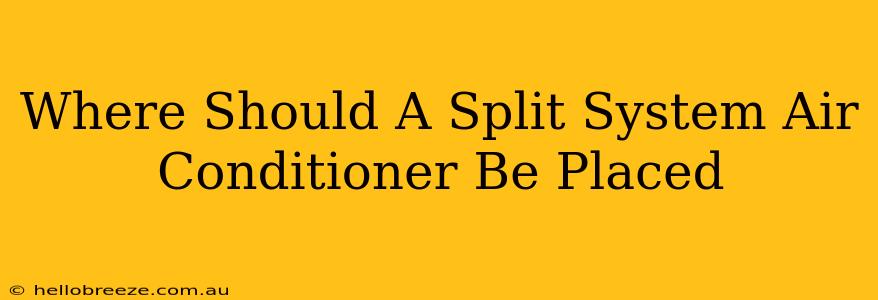Choosing the right location for your split system air conditioner is crucial for optimal performance, energy efficiency, and a comfortable indoor environment. Getting it wrong can lead to poor cooling, higher energy bills, and even damage to your unit. This guide will walk you through the key considerations for placing your split system effectively.
Understanding Split System Components
Before diving into placement, let's quickly recap the two main components:
- Indoor Unit (Evaporator): This unit sits inside your home, distributing cool air. Its placement significantly impacts cooling efficiency and comfort.
- Outdoor Unit (Condenser): This unit sits outside, releasing heat. Its placement affects its lifespan and operational efficiency.
Ideal Placement for the Indoor Unit
The indoor unit should be strategically positioned to maximize its cooling potential. Consider these factors:
1. Air Circulation:
- Avoid Obstructions: Ensure ample space around the indoor unit (at least 30cm/1ft on all sides). Furniture, curtains, and other obstructions can restrict airflow and reduce cooling efficiency.
- Central Location (if possible): Placing the unit in a central location helps to distribute cool air more evenly throughout the room. However, this isn't always feasible due to structural limitations.
- Consider Room Layout: The unit's placement should work with the room's natural airflow patterns to avoid dead zones where air doesn't circulate properly.
2. Ceiling Height & Mounting:
- Sufficient Height: Mounting the unit too low can cause drafts and discomfort. Ideally, it should be positioned at least 2.1 meters (7 feet) from the floor.
- Wall Mounting: Secure wall mounting is essential for safety and stability. Improper installation can lead to damage or even injury. Professional installation is highly recommended.
3. Proximity to Supply and Return Air Vents:
- Strategic Positioning: If possible, position the indoor unit away from existing supply and return air vents to avoid conflicting airflow patterns.
4. Noise Levels:
- Minimize Noise: While modern units are quieter, it’s still beneficial to consider placing the indoor unit away from areas where noise might be disruptive, such as bedrooms or quiet study areas.
Ideal Placement for the Outdoor Unit
The outdoor unit needs a suitable environment to operate efficiently and safely. Here's what to keep in mind:
1. Shade & Ventilation:
- Direct Sunlight: Avoid placing the outdoor unit in direct sunlight, as this can increase its operating temperature and reduce efficiency. Consider shaded areas.
- Air Circulation: Ensure good air circulation around the unit. Avoid placing it near walls or other obstructions that restrict airflow.
- Level Ground: The unit needs to be placed on a level, stable surface to prevent vibrations and ensure proper drainage.
2. Proximity to the Indoor Unit:
- Minimize Distance: While not always possible, keep the distance between the indoor and outdoor units as short as possible to minimize refrigerant line length and potential heat loss.
- Accessible for Maintenance: Ensure that the outdoor unit is easily accessible for regular maintenance and cleaning.
3. Safety and Regulations:
- Clearance: Ensure there's sufficient clearance around the outdoor unit, complying with all manufacturer and local regulations.
- Flammable Materials: Keep away from flammable materials.
- Obstructions: Avoid placing it near any obstruction that might restrict airflow or block access for maintenance.
Professional Installation is Key
While this guide provides helpful insights, professional installation is strongly recommended. A qualified HVAC technician will ensure your split system is installed correctly, safely, and operates at peak efficiency. Improper installation can void warranties and lead to costly repairs down the line.
By carefully considering these placement guidelines, you can ensure your split system air conditioner provides years of reliable, energy-efficient cooling. Invest the time to plan the placement properly – it will pay off in comfort and cost savings.

